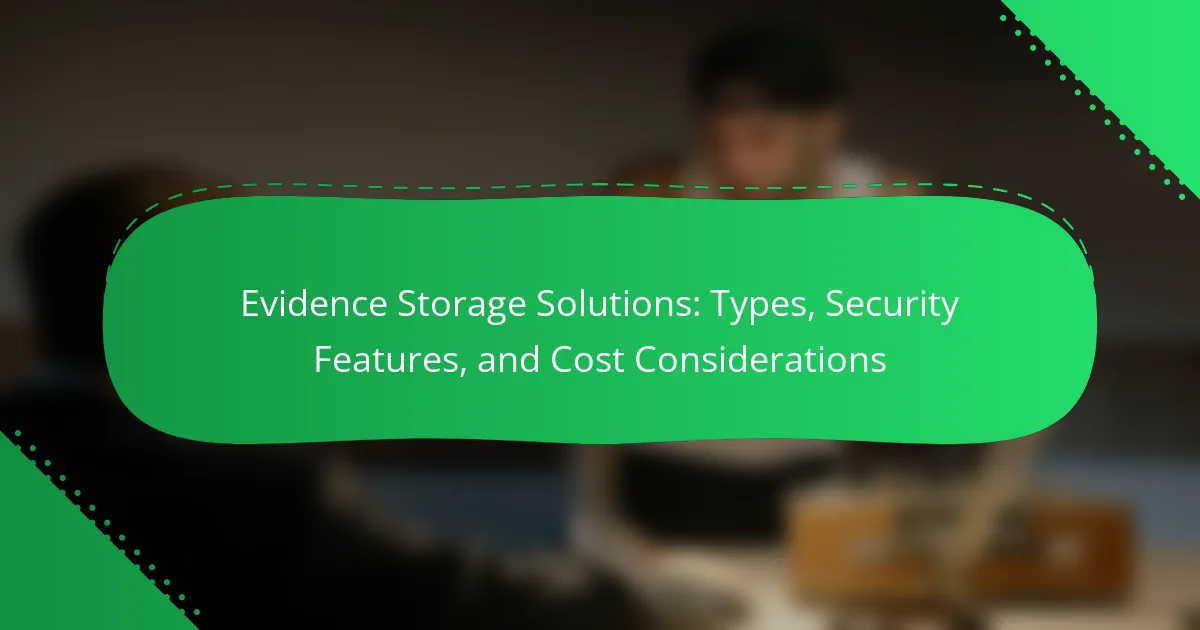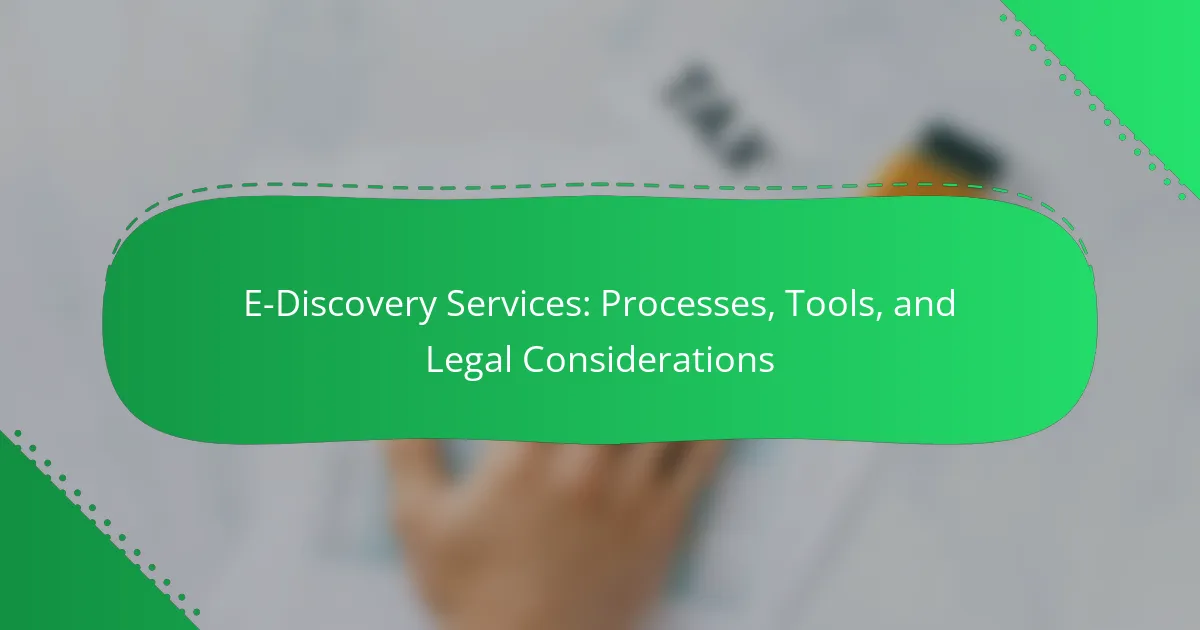Evidence storage solutions are systems developed to securely store and manage evidence for law enforcement and legal purposes, ensuring the integrity, security, and accessibility of both physical and digital evidence. These solutions encompass various types, including physical storage facilities, digital data management systems, and mobile evidence collection units, all designed with features like climate control, surveillance, and access control. The article will explore the key factors influencing the cost of these solutions, such as size, security features, and location, as well as the importance of compliance with legal standards. Additionally, it will provide guidance on how organizations can effectively choose the right evidence storage solution based on their specific needs, security requirements, and budget considerations.

What are Evidence Storage Solutions?
Evidence storage solutions are systems designed to securely store and manage evidence for law enforcement and legal purposes. These solutions ensure the integrity, security, and accessibility of physical and digital evidence. They often include features such as climate control, surveillance, and access control to protect sensitive materials. Various types of evidence storage solutions exist, including physical storage facilities, digital data management systems, and mobile evidence collection units. The effectiveness of these solutions is supported by standards set by organizations like the International Association for Property and Evidence (IAPE). Proper evidence storage is crucial for maintaining the chain of custody and ensuring legal compliance.
How do Evidence Storage Solutions function?
Evidence storage solutions function by securely managing and preserving physical and digital evidence. They utilize controlled environments to maintain the integrity of evidence. These solutions often include temperature and humidity controls for physical items. Digital evidence is stored in encrypted formats to prevent unauthorized access. Access to evidence is typically logged and monitored for accountability. Many solutions integrate with case management systems for streamlined tracking. They ensure compliance with legal standards for evidence handling. This functionality helps maintain the chain of custody, which is crucial in legal proceedings.
What components are essential for Evidence Storage Solutions?
Essential components for Evidence Storage Solutions include secure storage facilities, inventory management systems, and environmental controls. Secure storage facilities protect evidence from tampering and unauthorized access. Inventory management systems track evidence from collection to storage, ensuring accountability. Environmental controls maintain appropriate conditions for sensitive materials, preventing degradation. These components work together to safeguard integrity and reliability of evidence throughout its lifecycle.
How do these components impact the effectiveness of Evidence Storage Solutions?
The components of Evidence Storage Solutions significantly impact their effectiveness. Key components include security features, storage capacity, and accessibility. Enhanced security features prevent unauthorized access, ensuring the integrity of evidence. Adequate storage capacity allows for the retention of large volumes of evidence without loss. Accessibility ensures that authorized personnel can retrieve evidence quickly when needed. These factors collectively enhance the reliability and efficiency of evidence management. A study by the National Institute of Justice highlights that improved security measures reduce evidence tampering incidents by up to 30%. This demonstrates the direct correlation between component quality and overall effectiveness.
What are the primary types of Evidence Storage Solutions?
The primary types of evidence storage solutions include physical storage, digital storage, and hybrid storage. Physical storage involves secure locations like evidence lockers or cabinets. These facilities must adhere to strict security protocols to prevent tampering. Digital storage utilizes electronic systems for managing evidence data. This type often includes cloud storage and encrypted databases. Hybrid storage combines both physical and digital methods for comprehensive evidence management. Each type addresses specific needs for security, accessibility, and compliance in evidence handling.
What distinguishes physical evidence storage from digital evidence storage?
Physical evidence storage involves tangible items, while digital evidence storage pertains to electronic data. Physical evidence requires secure, controlled environments to prevent contamination or damage. This includes evidence lockers or climate-controlled rooms. Digital evidence needs cybersecurity measures to protect against unauthorized access or data loss. Each type has unique handling protocols; physical evidence often requires chain-of-custody documentation, while digital evidence may involve encryption and secure backups. The distinct nature of each type of evidence storage is crucial for maintaining integrity and admissibility in legal contexts.
How do specialized evidence lockers enhance security?
Specialized evidence lockers enhance security by providing controlled access and robust physical protection. These lockers are designed with advanced locking mechanisms that prevent unauthorized entry. Many models feature biometric access controls, such as fingerprint scanners, ensuring only authorized personnel can access the contents. Additionally, the construction materials are often tamper-resistant and durable, making it difficult for intruders to breach them.
Evidence lockers also include surveillance capabilities, such as integrated cameras that monitor access and record activity. This creates an audit trail that can be reviewed if security breaches occur. Furthermore, these lockers often have environmental controls to protect sensitive evidence from damage. Overall, the combination of these features significantly reduces the risk of theft, tampering, and loss of evidence.
What security features are critical in Evidence Storage Solutions?
Critical security features in Evidence Storage Solutions include data encryption, access controls, and audit trails. Data encryption protects sensitive evidence from unauthorized access. Access controls ensure that only authorized personnel can retrieve or modify stored evidence. Audit trails provide a record of all actions taken on the evidence, enhancing accountability and traceability. These features are essential for maintaining the integrity and confidentiality of evidence in legal contexts. Implementing these security measures helps prevent tampering and ensures compliance with legal standards.
How does access control enhance the security of evidence storage?
Access control enhances the security of evidence storage by restricting unauthorized access to sensitive materials. It ensures that only authorized personnel can enter storage areas. This minimizes the risk of tampering, theft, or loss of evidence. Implementing access control measures, such as key cards or biometric systems, creates an audit trail. This trail records who accessed the evidence and when. According to the National Institute of Standards and Technology, secure access controls significantly reduce security breaches. Thus, effective access control is crucial for maintaining the integrity of evidence storage.
What role does encryption play in digital evidence storage?
Encryption secures digital evidence storage by protecting data from unauthorized access. It ensures that sensitive information remains confidential and integral. Encryption algorithms convert readable data into an unreadable format, which can only be decrypted with a specific key. This process safeguards evidence from tampering and breaches. According to the National Institute of Standards and Technology, encryption is a critical component in maintaining the integrity of digital evidence. It also complies with legal and regulatory requirements for data protection. By using encryption, organizations can enhance their security posture and build trust in their evidence handling practices.

What factors influence the cost of Evidence Storage Solutions?
The cost of Evidence Storage Solutions is influenced by several key factors. These factors include the size and capacity of the storage system. Larger systems typically incur higher costs due to increased materials and technology requirements. Security features significantly impact pricing as advanced security measures add to the overall expense.
The type of storage solution chosen also affects costs. Traditional physical storage may differ in price compared to digital storage systems. Maintenance and operational costs are additional considerations. Regular maintenance can lead to ongoing expenses over time.
Location can influence costs as well. Storage solutions in urban areas may have higher rental or operational costs than those in rural locations. Lastly, compliance with legal and regulatory requirements can add to the cost. Meeting specific standards often necessitates additional features or services.
How do different types of storage impact overall costs?
Different types of storage significantly impact overall costs. Traditional on-premises storage often incurs higher upfront capital expenses. This includes hardware purchase, maintenance, and infrastructure costs. Cloud storage, in contrast, typically operates on a pay-as-you-go model. This can lead to lower initial investments and predictable ongoing expenses.
However, cloud storage costs can escalate with high data transfer and retrieval rates. Specialized storage solutions, such as cold storage, are cheaper for infrequently accessed data. According to a report by Gartner, organizations can save up to 30% by optimizing their storage strategy.
In summary, the choice between on-premises, cloud, and specialized storage directly influences financial implications. Each type has its own cost structure based on usage, maintenance, and accessibility.
What are the initial setup costs associated with various storage solutions?
Initial setup costs for various storage solutions vary widely. Traditional on-premises storage systems can range from $10,000 to $100,000. This cost includes hardware, software, and installation fees. Cloud storage solutions typically require lower upfront investment. Monthly fees for cloud services can range from $100 to $1,000 based on storage capacity and features. Automated storage systems often start at $50,000 and can exceed $500,000 depending on complexity. Mobile storage units may cost between $5,000 and $30,000, depending on size and customization. These costs reflect the initial investment required to establish effective storage solutions for evidence management.
How do ongoing maintenance costs vary between storage types?
Ongoing maintenance costs vary significantly between different storage types. For instance, physical storage solutions like warehouses incur costs for utilities, security, and climate control. These costs can range from $1 to $3 per square foot monthly, depending on location and security measures. In contrast, digital storage solutions often have lower maintenance costs. Cloud storage typically charges based on usage, averaging around $0.01 to $0.10 per GB per month. This model can lead to lower overall costs as scaling needs change. Additionally, specialized storage solutions for sensitive evidence may require more robust security and environmental controls, increasing maintenance costs. Overall, the choice of storage type directly impacts ongoing maintenance expenses.
What are the long-term financial implications of Evidence Storage Solutions?
Long-term financial implications of Evidence Storage Solutions include reduced operational costs and improved efficiency. Investing in these solutions can lead to significant savings in storage space and resource management. For instance, digital evidence storage minimizes physical space requirements, reducing overhead costs. Additionally, streamlined access to evidence can decrease labor hours spent on retrieval and management. Studies indicate that organizations adopting advanced storage solutions experience up to a 30% reduction in evidence handling costs over five years. Furthermore, enhanced security features reduce the risk of costly data breaches or legal liabilities. Overall, the initial investment in Evidence Storage Solutions yields substantial long-term financial benefits.
How can investing in high-quality solutions reduce future costs?
Investing in high-quality solutions reduces future costs by enhancing durability and reliability. These solutions often require less frequent replacements, leading to lower long-term expenses. High-quality materials and technology can minimize maintenance needs. For example, robust evidence storage solutions can withstand environmental factors better than cheaper options. This results in fewer incidents of damage or data loss. According to a study by the National Institute of Standards and Technology, high-quality systems can reduce operational costs by up to 30% over their lifespan. Thus, the initial investment in quality leads to significant savings over time.
What are the potential costs of inadequate evidence storage?
Inadequate evidence storage can lead to significant financial and legal costs. Loss or damage to evidence may result in case dismissals or wrongful convictions. This can increase litigation expenses and settlements. Additionally, poor storage practices can lead to regulatory fines for non-compliance with evidence handling standards. The costs associated with retraining staff on proper storage methods can also add up. In some cases, organizations may face reputational damage, resulting in loss of clients or contracts. Overall, the potential costs of inadequate evidence storage can be substantial and far-reaching.

How can organizations effectively choose Evidence Storage Solutions?
Organizations can effectively choose evidence storage solutions by assessing their specific needs and requirements. They should evaluate the types of evidence they need to store, such as digital files or physical items. Security features are crucial; solutions must comply with legal regulations and ensure data integrity. Cost considerations also play a vital role; organizations should compare pricing models and total cost of ownership. Additionally, scalability is important, as organizations may need to expand their storage capacity over time. User-friendliness of the interface can impact operational efficiency. Finally, consulting reviews and case studies can provide insights into the effectiveness of various solutions.
What criteria should be considered when selecting an evidence storage solution?
When selecting an evidence storage solution, consider security, accessibility, scalability, and compliance. Security ensures that sensitive evidence is protected from unauthorized access. Accessibility allows authorized personnel to retrieve evidence efficiently. Scalability accommodates future growth in evidence volume. Compliance with legal and regulatory standards is essential for maintaining the integrity of evidence. These criteria are critical for ensuring effective evidence management and protection.
How do organizational needs influence the choice of storage type?
Organizational needs significantly influence the choice of storage type. The specific requirements of an organization dictate the type of storage solution that will be most effective. For instance, organizations with high security requirements may opt for encrypted cloud storage or secure on-premises solutions. In contrast, organizations that prioritize cost-effectiveness might choose less secure, lower-cost options. Additionally, the volume of data an organization handles impacts storage type selection. Large organizations often require scalable solutions that can grow with their data needs. Compliance with regulations also plays a critical role. Organizations must select storage types that meet legal and industry standards for data retention and security. Thus, organizational needs guide decisions on security features, scalability, and compliance, ultimately shaping the storage type chosen.
What are the best practices for evaluating storage security features?
The best practices for evaluating storage security features include assessing data encryption methods, access controls, and compliance with regulations. Data encryption protects stored information from unauthorized access. Strong access controls limit who can view or modify data. Compliance with industry standards, such as GDPR or HIPAA, ensures legal protection of sensitive information. Additionally, consider the storage solution’s audit capabilities to track access and modifications. Evaluate the provider’s reputation and history regarding security breaches. Regular security assessments and updates are also essential to maintain robust protection.
What tips can help organizations optimize their Evidence Storage Solutions?
Organizations can optimize their Evidence Storage Solutions by implementing a structured organization system. Categorizing evidence by type and case number enhances retrieval efficiency. Regular audits ensure compliance with storage protocols and identify areas for improvement. Utilizing digital storage can reduce physical space requirements and improve accessibility. Implementing advanced security measures protects sensitive information from unauthorized access. Training staff on best practices promotes proper handling and documentation of evidence. Investing in scalable storage solutions accommodates future growth and changes in evidence volume. Regularly reviewing and updating storage policies keeps the organization aligned with industry standards and legal requirements.
How can regular audits improve evidence storage practices?
Regular audits enhance evidence storage practices by ensuring compliance and identifying weaknesses. They systematically review storage protocols and procedures. This process helps in detecting discrepancies in evidence handling. Regular audits can reveal outdated storage technologies or methods. They also promote accountability among staff members. By enforcing best practices, audits reduce the risk of evidence tampering or loss. Furthermore, they facilitate continuous improvement in storage systems. Evidence storage organizations that conduct audits report increased efficiency and security.
What role does staff training play in maintaining evidence integrity?
Staff training plays a crucial role in maintaining evidence integrity. Properly trained staff understand the protocols for handling, storing, and documenting evidence. This knowledge minimizes the risk of contamination, loss, or mishandling of evidence. Training ensures that staff are aware of legal requirements and best practices in evidence management. For instance, the International Association for Property and Evidence emphasizes ongoing training to uphold evidence chain of custody. Regular training sessions can significantly reduce human error, which is a common factor in evidence mishandling. Ultimately, well-trained staff contribute to the overall reliability of the evidence used in legal proceedings.
Evidence storage solutions are systems designed to securely store and manage evidence for law enforcement and legal purposes, ensuring integrity, security, and accessibility. The article covers various types of evidence storage solutions, including physical, digital, and hybrid methods, while highlighting essential components such as secure storage facilities, inventory management systems, and environmental controls. It also discusses critical security features, the impact of storage type on costs, and best practices for selecting and optimizing these solutions. Key considerations include compliance with legal standards, scalability, and the importance of staff training in maintaining evidence integrity.



